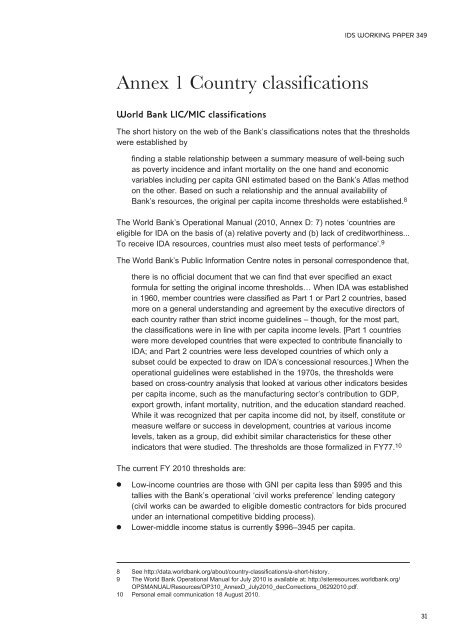Andy Sumner - Institute of Development Studies
Andy Sumner - Institute of Development Studies
Andy Sumner - Institute of Development Studies
Create successful ePaper yourself
Turn your PDF publications into a flip-book with our unique Google optimized e-Paper software.
IDS WORKING PAPER 349Annex 1 Country classificationsWorld Bank LIC/MIC classificationsThe short history on the web <strong>of</strong> the Bank’s classifications notes that the thresholdswere established byfinding a stable relationship between a summary measure <strong>of</strong> well-being suchas poverty incidence and infant mortality on the one hand and economicvariables including per capita GNI estimated based on the Bank’s Atlas methodon the other. Based on such a relationship and the annual availability <strong>of</strong>Bank’s resources, the original per capita income thresholds were established. 8The World Bank’s Operational Manual (2010, Annex D: 7) notes ‘countries areeligible for IDA on the basis <strong>of</strong> (a) relative poverty and (b) lack <strong>of</strong> creditworthiness...To receive IDA resources, countries must also meet tests <strong>of</strong> performance’. 9The World Bank’s Public Information Centre notes in personal correspondence that,there is no <strong>of</strong>ficial document that we can find that ever specified an exactformula for setting the original income thresholds… When IDA was establishedin 1960, member countries were classified as Part 1 or Part 2 countries, basedmore on a general understanding and agreement by the executive directors <strong>of</strong>each country rather than strict income guidelines – though, for the most part,the classifications were in line with per capita income levels. [Part 1 countrieswere more developed countries that were expected to contribute financially toIDA; and Part 2 countries were less developed countries <strong>of</strong> which only asubset could be expected to draw on IDA’s concessional resources.] When theoperational guidelines were established in the 1970s, the thresholds werebased on cross-country analysis that looked at various other indicators besidesper capita income, such as the manufacturing sector’s contribution to GDP,export growth, infant mortality, nutrition, and the education standard reached.While it was recognized that per capita income did not, by itself, constitute ormeasure welfare or success in development, countries at various incomelevels, taken as a group, did exhibit similar characteristics for these otherindicators that were studied. The thresholds are those formalized in FY77. 10The current FY 2010 thresholds are:●●Low-income countries are those with GNI per capita less than $995 and thistallies with the Bank’s operational ‘civil works preference’ lending category(civil works can be awarded to eligible domestic contractors for bids procuredunder an international competitive bidding process).Lower-middle income status is currently $996–3945 per capita.8 See http://data.worldbank.org/about/country-classifications/a-short-history.9 The World Bank Operational Manual for July 2010 is available at: http://siteresources.worldbank.org/OPSMANUAL/Resources/OP310_AnnexD_July2010_decCorrections_06292010.pdf.10 Personal email communication 18 August 2010.31
















